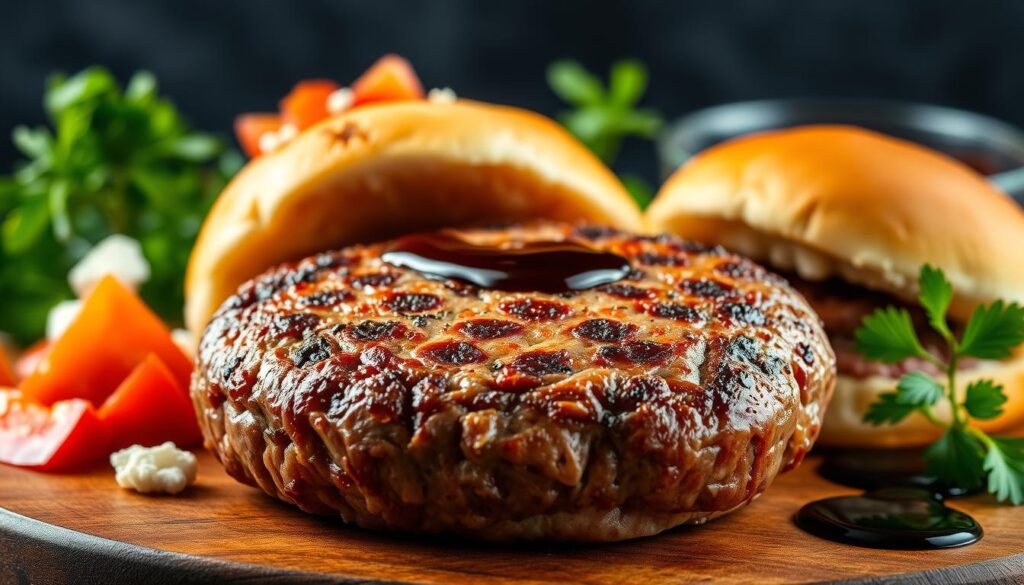Ground Chuck: A Flavorful Meat for Any Dish
When it comes to cooking a delicious meal, the type of meat you choose can make all the difference. For many home cooks and chefs, ground chuck is the go-to option for its rich flavor and versatility.
ground beef, particularly ground chuck, offers an ideal balance of meat and fat, resulting in juicier and more flavorful dishes.
Whether you’re making beef burgers, meatloaf, or pasta sauces, understanding the unique properties of ground chuck can help you make better-informed decisions when selecting ground beef for your recipes.
Key Takeaways
- It is a versatile and flavorful type of ground beef.
- It comes from the shoulder region of the cow, offering a good balance of meat and fat.
- The optimal fat content delivers superior flavor and juiciness.
- It’s a popular choice among home cooks and professional chefs alike.
- It is widely available in grocery stores and butcher shops.
What Makes Ground Chuck Different
When it comes to ground beef, ground chuck stands out from the rest because of its distinct characteristics. You might be wondering what sets it apart from other types of ground beef. The answer lies in its origin, composition, and nutritional profile.
Definition and Origin
This meat is derived specifically from the chuck primal cut, which comes from the shoulder area of the beef cattle. This cut includes portions of the neck, shoulder blade, and upper arm, making it a flavorful and tender option. The chuck primal cut is known for its rich flavor and ideal meat-to-fat ratio.
The Chuck Cut: Location and Characteristics
The chuck cut features well-exercised muscles that develop rich flavor, along with an ideal distribution of fat. This creates the perfect 80/20 lean-to-fat ratio, making it most desirable for juicy burgers and flavorful meat dishes.
The unique combination of connective tissue and intramuscular fat in the chuck cut breaks down during cooking, resulting in a tender and moist final product.
Fat Content and Nutritional Profile
This type of meat typically contains 78-84% lean meat, making it a good balance between flavor and nutrition. Nutritionally, it contains approximately 290 calories per 4-ounce serving, with about 23 grams of protein. This makes it a good source of complete protein while maintaining enough fat for flavor.
| Nutritional Information (per 4-oz serving) | Ground Chuck |
|---|---|
| Calories | 290 |
| Protein | 23g |
| Fat Content | 16-22% |
By understanding the characteristics of ground chuck, you can make informed decisions about your cooking and choose the best options for your recipes. Whether you’re making burgers, meatloaf, or chili, it is a versatile and flavorful choice.
Ground Chuck vs. Other Types
When it comes to cooking with ground beef, understanding the differences between various types is crucial for achieving the best results.
In the United States, ground beef is categorized based on the cut and fat percentage, with the main types being ground chuck, ground round, ground sirloin, and regular ground beef.
Ground Chuck (80/20) Characteristics
It is known for its 80/20 lean-to-fat ratio, which provides optimal juiciness and flavor. This makes it the preferred choice for hamburgers and recipes where moisture retention is important. The higher fat content ensures that your burgers remain juicy and flavorful.
Ground Round (85-89% Lean) Comparison
In contrast, ground round comes from the rear leg of the animal and contains 85-89% lean meat. It offers less fat but still maintains reasonable moisture and flavor, making it a good option for health-conscious consumers. Ground round is a leaner alternative that still packs plenty of flavor.
Ground Sirloin (90-95% Lean) Comparison
Ground sirloin, derived from the mid-section below the ribs, is the leanest option at 90-95% lean. While it’s suitable for those prioritizing lower fat content, it can produce drier results when overcooked. Ground sirloin is ideal for recipes where a leaner ground beef is preferred.
Regular Ground Beef Differences
Regular ground beef, sometimes labeled simply as “ground beef,” can contain various trimmings from different parts of the animal.
It typically has a fat content similar to ground chuck but with less consistent flavor. Regular ground beef is often the most economical option but may lack the quality and consistency of other types.
| Type of Ground Beef | Lean-to-Fat Ratio | Characteristics |
|---|---|---|
| Ground Chuck | 80/20 | Juicy, flavorful, higher fat content |
| Ground Round | 85-89% lean | Leaner, reasonable moisture, less fat |
| Ground Sirloin | 90-95% lean | Leanest, can be dry if overcooked |
| Regular Ground Beef | Variable | Economical, less consistent flavor |
Understanding these differences allows you to select the appropriate ground beef type based on your specific recipe requirements, dietary preferences, and budget considerations. By choosing the right type, you can ensure that your dishes turn out as desired.
Flavor and Texture Benefits
This meat stands out among other types due to its unique characteristics that enhance both flavor and texture. The distinct advantages of using it in your cooking are primarily attributed to its optimal fat content and how it behaves during cooking.
Why Fat Content Matters for Flavor
The fat content plays a crucial role in carrying flavor compounds that dissolve in fat but not in water. This results in a more robust and satisfying taste experience compared to leaner options. The 20% fat content is particularly effective in enhancing the overall flavor profile of dishes made with this meat.
- The fat acts as a carrier for flavors, making each bite more savory.
- It contributes to a richer, more complex taste experience.
Texture Advantages When Cooked
When cooked, the fat melts and distributes throughout the meat, basting it from within. This process prevents the meat from becoming dry and crumbly, a common issue with leaner varieties. As a result, it maintains a tender, juicy texture that is ideal for burgers and other dishes where texture is crucial.
Moisture Retention During Cooking
The optimal fat content also aids in moisture retention during cooking. This characteristic makes it forgiving for home cooks, as it remains juicy even when cooked to higher temperatures.
Unlike leaner varieties, which can quickly become tough and dry, the balance of protein and fat creates the perfect environment for Maillard reactions, developing complex flavors and appealing browning.
- It retains moisture better than leaner options.
- It is less likely to dry out during cooking.
Best Culinary Uses

Whether you’re making burgers, meatballs, or pasta sauces, it is a superior choice that delivers consistently delicious results. Its unique blend of flavor, texture, and fat content makes it an ideal ingredient for a variety of dishes.
Perfect for Juicy Hamburgers
The ideal fat content makes it the premier choice for juicy, flavorful hamburgers that maintain their moisture even when cooked to medium or medium-well temperatures.
The fat percentage ensures that your burgers stay tender and full of flavor, making it a favorite among burger enthusiasts.
Ideal for Meatloaf and Meatballs
When making meatloaf and meatballs, it provides the perfect balance of structure and tenderness. It allows the mixture to hold together while remaining moist and flavorful throughout the cooking process. This results in a more enjoyable eating experience and a dish that’s sure to impress.
Using It in Pasta Dishes
In pasta dishes like spaghetti bolognese and lasagna, it contributes rich flavor and a satisfying texture that stands up to long simmering times. This allows the flavors to fully develop, creating a complex and satisfying sauce that complements the pasta perfectly.
For Chili and Stews
The fat content makes it ideal for chili and stews, where it remains tender during extended cooking times while releasing flavor compounds that enhance the entire dish. This results in a hearty, comforting meal that’s perfect for cold weather or special occasions.
It is a versatile ingredient that can be used in a variety of other dishes, including tacos, shepherd’s pie, stuffed peppers, and casseroles. Its flavor and moisture retention properties enhance the overall eating experience, making it a staple in many kitchens.
Buying and Storing
To get the most out of it, it’s essential to know what to look for when buying it. It is a popular choice for many recipes due to its rich flavor and tender texture.
What to Look for When Purchasing
When purchasing at the grocery store, look for packages with a bright cherry-red color and minimal liquid in the package.
The labeling should clearly indicate that it’s ground chuck with approximately 80% lean/20% fat content. Fresh ground beef should have a clean, slightly sweet smell with no sour or off odors.
- Check the color and packaging
- Verify the lean to fat ratio
- Smell for freshness
Price Considerations vs. Other Types
It typically costs more than regular ground beef but less than premium options like ground sirloin. You can expect to pay approximately $4.50-$6.00 per pound in most U.S. markets, offering an excellent balance of quality and value.
| Type of Ground Beef | Price Range per Pound | Lean to Fat Ratio |
|---|---|---|
| Regular Ground Beef | $3.50-$4.50 | 70/30 or 75/25 |
| Ground Chuck | $4.50-$6.00 | 80/20 |
| Ground Sirloin | $6.00-$8.00 | 90/10 or 95/5 |
Proper Storage and Shelf Life
For optimal freshness, store it in the coldest part of your refrigerator (below 40°F) and use within 1-2 days of purchase. If you won’t be using it within that timeframe, freeze it immediately.
When freezing, wrap the original packaging in freezer paper or place in a freezer-safe bag with the air pressed out to prevent freezer burn.
A 4-ounce serving contains approximately 290 calories and 23 grams of protein, making it a nutrient-dense option for those looking to balance flavor with nutritional considerations.
Conclusion: Why Choose It for Your Recipes
For home cooks seeking consistent flavor and texture, ground chuck is an ideal option. With its optimal fat content of 80/20, it provides excellent flavor and juiciness, making it a popular choice for many recipes.
A 4-ounce serving contains approximately 290 calories and 23 grams of protein, offering substantial nutrition while delivering rich, satisfying flavor.
The versatility of it makes it suitable for a wide range of dishes, from weeknight burgers to Sunday meatloaf and special bolognese sauce. Its consistent quality and flavor profile, derived from a specific part of the animal, set it apart from generic ground beef.
While leaner options like ground round or ground sirloin may appeal to those counting calories, ground chuck delivers a significantly better eating experience for only marginally more calories.
When you choose ground chuck for your recipes, you’re selecting a cut that offers reliability, flavor, and texture, elevating your dishes from ordinary to exceptional.
As you explore different recipes and cooking methods, you’ll find that ground chuck’s versatility makes it the most practical and delicious ground beef option to keep on hand in your kitchen.




